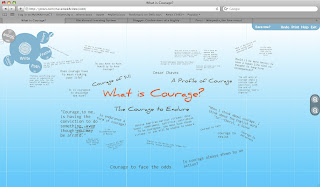
Before I took Ed Tech and Design, I was vaguely familiar with what a blog was, but I didn't really know why anyone would take the time to read them, let alone make them. But after we started working with blogs in the classroom, I have to admit that I was both impressed and excited about the idea of using them in the classroom. So, I decided to do a little research to see how teachers utilize blogs in their lesson plans, if any actually do, and whether or not students visit teacher-made blogs. Education World, the Educator's Best Friend, is an amazing web resource that consolidates tons of educational information for teachers into one intensely useful website. Here, I found an article on blogs that opened my eyes to the possibilities that they offer educators in the classroom. Blogging? It's Elementary, My Dear Watson! is the title of the article which I am about to discuss.
Apparently, blogging started off as a web tool for anyone who wanted to write about anything and post it online for others to view and comment on. One famous story of blogging is that of Julie Powell, a creative writing major working for the Lower Manhattan Development Corporation who, in 2002, began her blog called The Julie/Julia Project. Her goal was to cook all 524 recipes featured in Julia Child's Mastering the Art of French Cooking
in 365 days. The blog gained a large following and soon allowed Julie to publish several books and have a film created based on her story. To get back on track, blogging can mean just about anything to an individual, and it has certainly started to become more and more prominent in the classroom today.
According to the blogging article, students find it more meaningful to write if they have a real audience that they know will be reading what they compose. Using blogs in the classroom will allow students to share and view material that they have created. Teachers who blog can post topics or interesting articles, pictures and videos and then ask their students to view the material and blog about their opinions of the materials. Not only may students comment on teacher blogs, they can also create blog responses. Web-based blogs are great for middle and high school students because they are easy access and usually free. For younger students, using a blog may be a great way for them to develop their writing skills while at the same time learning about new issues and subjects. Some teachers may assign students blog posts for homework, asking them to review the lesson learned in class and give their overview or thoughts on what was learned. Blogs provide another outlet for communication between students and teachers.
This video was made by a tenth grade communications technology class. It gives the top 10 reasons to use blogs in the classroom and is quite persuasive and the information presented is valid.
Blogging the classroom is a great idea for educators. I am really enjoying my blog that I created for Ed Tech and I plan on keeping it after the class is over. I want to continue blogging for my own enjoyment, and hopefully for the enjoyment of others as well. Here are some different blog sites that you can visit to learn more about blogs, or to start your own!
Blogger
LiveJournal
Blogmeister
KidzBlog
Thingamablog
Think.com
Blog photo from IowaAEAOnline iCLIPART
Video from Youtube.com-http://www.youtube.com/watch?v=PfJETK3am1M



